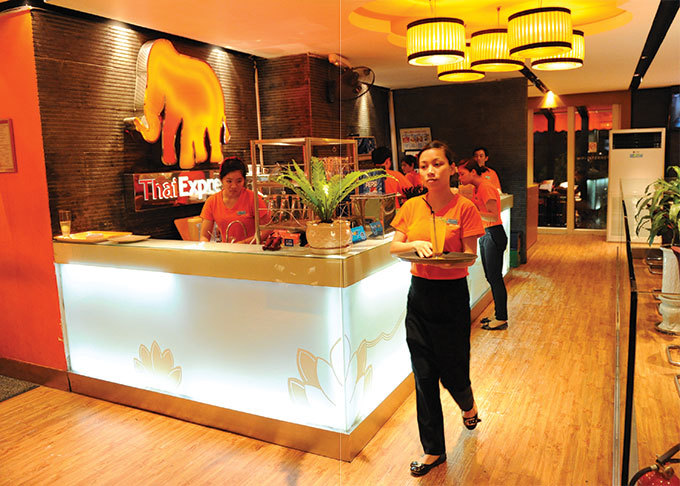 |
A range of restaurants under the banner Mon Hue and its sister chains were shuttered in Hanoi and Ho Chi Minh City in October. The company’s website and social media channels were also switched off.
Investors in Mon Hue then filed a lawsuit with the Ho Chi Minh City People’s Court against Mr. Huy Nhat, Founder of Mon Hue’s parent company, the Huy Vietnam Food Processing JSC.
While the lawsuit is still to play out, it brought some unwanted attention to Vietnam’s food and beverage (F&B) industry.
Analysts said it was an example of a large restaurant chain receiving massive amounts of money from investment funds and then facing difficulties and even closure after an initial period of heated growth.
No yellow-brick road
Huy Vietnam operates the Mon Hue, Pho Ong Hung, Com Tho Chay, Great Banh Mi, Pho 99, and TPTea brands.
It employed more than 2,500 local staff nationwide at its peak and served 47,000 safe and affordable meals every day, before more than 80 restaurants then closed their doors.
Mr. Sean T Ngo, CEO and Co-founder of VF Franchise Consulting, told VET that there are probably many reasons for the failure and closure of Mon Hue restaurants, such as insufficient cash flows to grow successfully, high rental costs, intense competition, poor supply chains, and difficulties in retaining key employees.
The lawsuit was initiated by a group of international private equity funds that have invested a total of over $70 million in the company since 2013, including ADV Partners, AIF Capital, F&H Fenghe, Fortress Investments, Gryphus Capital, and Welkin Capital.
Ms. Nguyen Phi Van, Co-founder of World Franchise Associates, pointed out that there are two trends in investment in chains: building a sustainable business, and building a product solely to boost financial transactions.
In the second, she explained, businesses will create a model and expand quickly, issuing “great” financial statements to invite investment funds.
As the latter hope to invest their capital, they often don’t pay sufficient attention to sustainable development.
“Their purpose is to expand and sell for a profit, and in this case the chain has collapsed,” Ms. Van said. She also told VET that the failure of Mon Hue relates to financial issues.
Location was also a key factor. While Mon Hue had restaurants in prime locations such as Vincom Ba Trieu, Pho Hue, Ba Trieu, and Tran Duy Hung in Hanoi, rentals for golden spots in both the capital and Ho Chi Minh City are high and rising.
According to a JLL quarterly report from October, ground floor asking rents in Hanoi’s CBD stood at $101.8 per sq m per month in the third quarter, an increase of 2.3 per cent year-on-year and 1.1 per cent quarter-on-quarter.
Rentals in Ho Chi Minh City’s retail market during the quarter were $135.5 per sq m per month in the CBD and $35.8 per sq m per month in non-CBD areas.
Even world-famous chain McDonald’s said that finding a suitable location in the heart of Hanoi was one of the key reasons it arrived late in Vietnam’s capital after opening 16 outlets in Ho Chi Minh City.
Before Mon Hue, the Pho 24 restaurant chain dominated Vietnam’s food chain business with 60 restaurants around the country and 20 overseas.
It agreed to being acquired by Viet Thai Ltd., the owner of the Highlands Coffee chain, in 2011.
Its restaurants are now concentrated in Ho Chi Minh City, where it has just 18, and two others at Hanoi’s Noi Bai International Airport and Da Nang International Airport, according to its website.
Mr. Ly Qui Trung, Founder of Pho 24, declined to speak with VET but told local media early this year that Pho 24 needed funds to refresh its image, brand, and marketing strategy.
Market optimism
Other F&B brands are facing similar issues but there are many that are thriving. Founded in 2005, Golden Gate now owns more than 20 brands and over 300 multi-style restaurants around the country and is constantly expanding. It posted revenue of some VND4 trillion ($172 million) in 2018, with an after-tax profit of VND269 billion ($11.5 million).
After more than eleven years in business, Redsun-ITI has 13 major brands with more than 200 restaurants in cities and provinces nationwide and abroad. It posted revenue of VND690 billion ($29.6 million) last year.
“Both Golden Gate and Redsun are phenomenal companies with many different restaurant brands in their portfolios, and both continue to grow at a breakneck pace,” said Mr. Ngo. “Each, though, has brands that over-perform and others that under-perform.”
The Ministry of Industry and Trade has said that 235 foreign brands are registered in Vietnam, in F&B and in fields such as fashion, retail, education, hospitality, and services.
Mr. Ngo said that to succeed, restaurants need to continue to focus on product, service, price, and promoting the brand.
“Understanding what consumers want and delivering it above and beyond expectations normally results in success,” he added. Meanwhile, Ms. Van said large global chains always resonate because of sustainable operations and financial transactions that enable them to develop efficiently.
“An effective and sustainable business model is a factor for success when investing in Vietnam’s F&B industry,” she said.
The market also exhibits many positive signs attracting other brands. Market researchers Nielsen forecast that by 2020, Vietnam will have about 44 million people in its middle-class and this will increase to 95 million by 2030. Middle-class households spend from $10-100 per person a month, 30-40 per cent of which is spent on F&B.
The JLL report also noted that along with fashion and lifestyle, F&B continues to see continued demand thanks to Vietnam’s young demographic and the rise of the middle-class.
According to Statista, revenue in Vietnam’s F&B market in 2019 may reach $200 billion, up 34.3 per cent against 2018, and more than double to some $408 billion by 2023.
Mr. Ngo believes that the F&B industry will grow by a healthy 10-15 per cent each year, driven primarily by growing disposable incomes and busier lifestyles that result in people eating out more and eating at home less. VN Economic Times
Ngoc Lan

Vietnam beverage industry potential appeals to foreign players
Listed among leading Asian consumers of alcoholic drinks, Vietnam remains potential for foreign investors.

Vietnam’s food and beverage sector draws foreign firms’ interest
Vietnam has become an increasingly attractive destination for international enterprises in the food, beverages and packaging industry thanks to its rapid economic growth and rising consumer demand.
 While some F&B brands in Vietnam have been forced out of business there are others that are prospering." itemprop="description" />
While some F&B brands in Vietnam have been forced out of business there are others that are prospering." itemprop="description" />